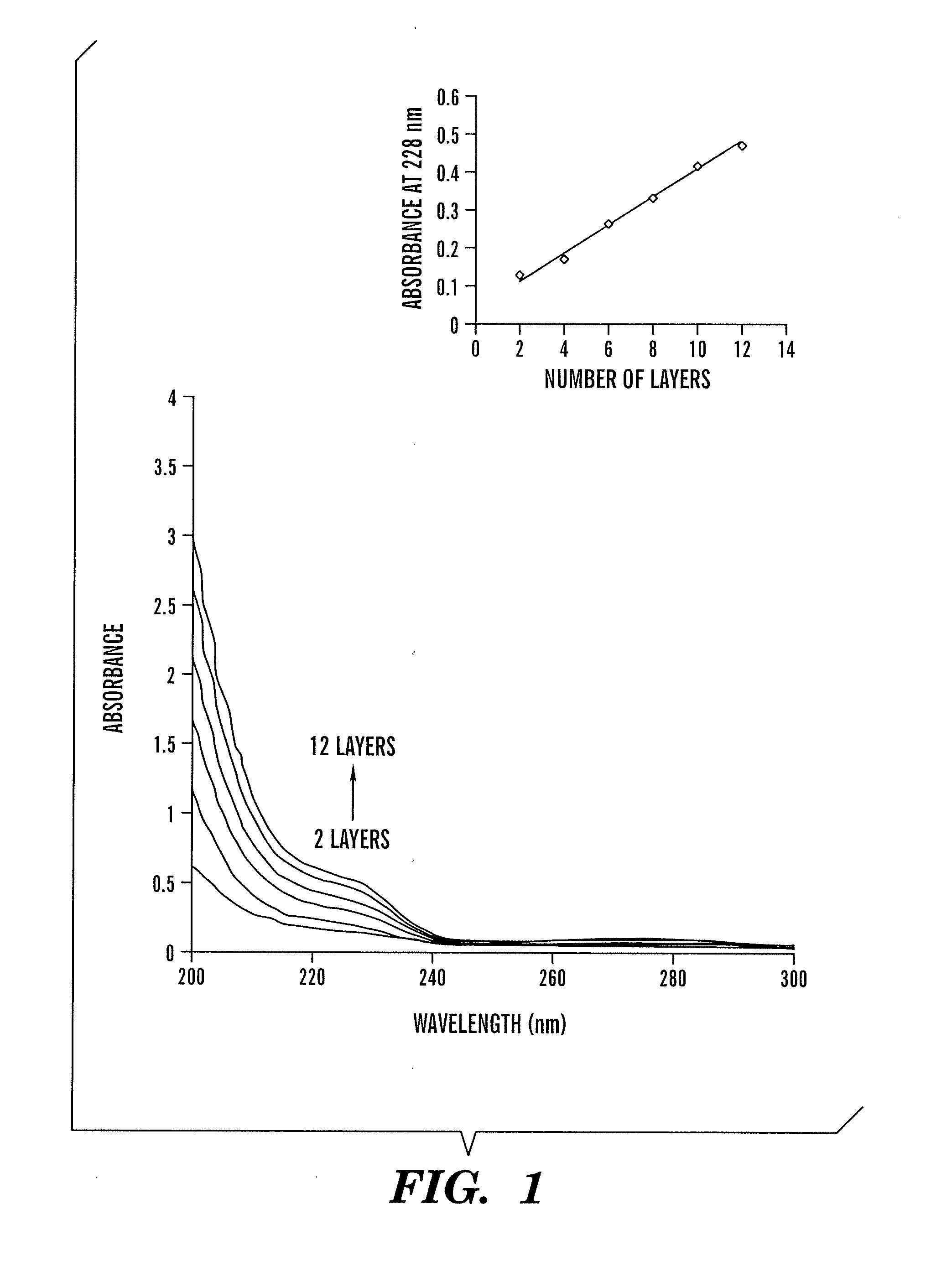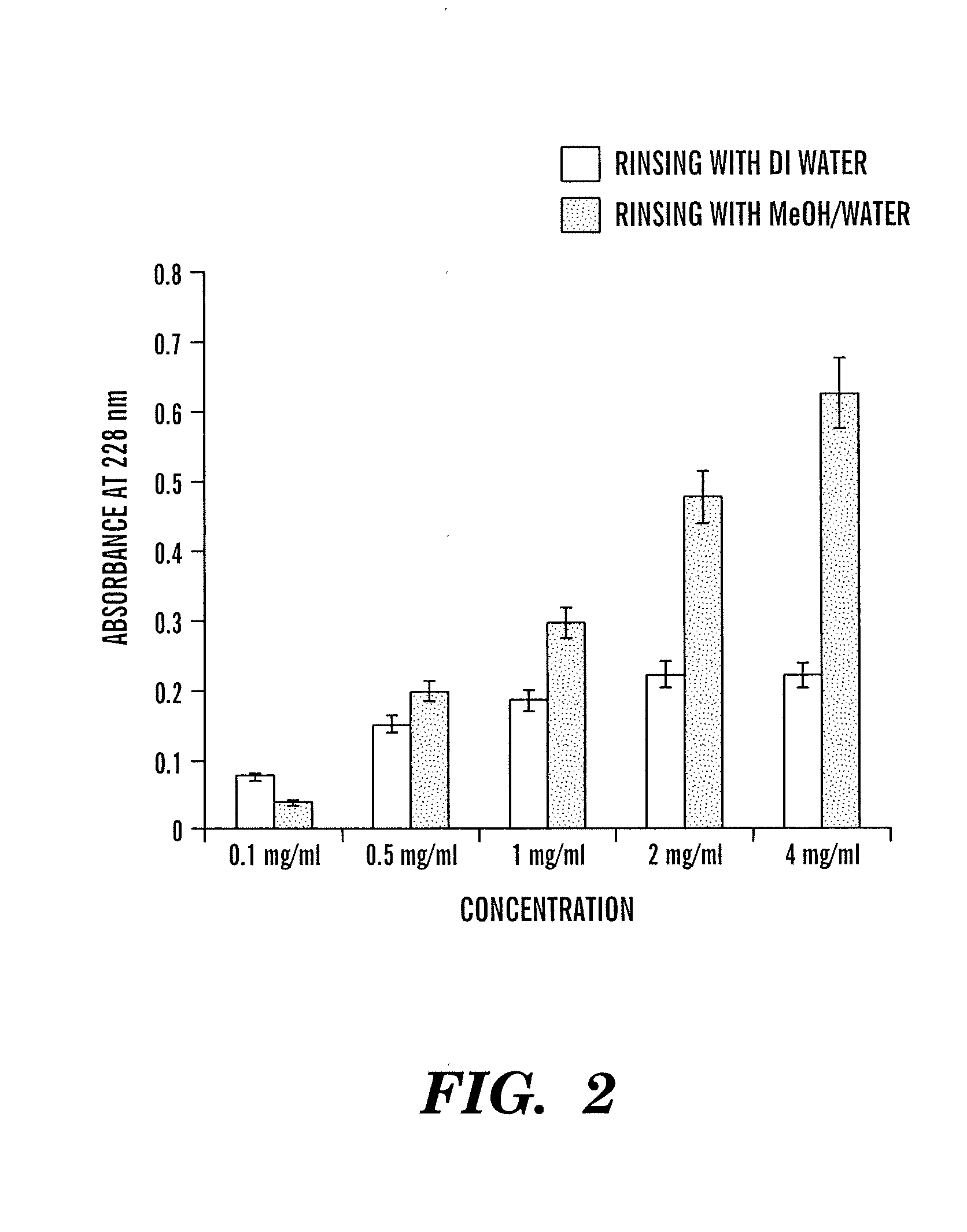Methods for stepwise deposition of silk fibroin coatings
a silk fibroin coating and stepwise technology, applied in the direction of peptides, drug compositions, prosthesis, etc., can solve the problems of limited control of biodegradation, loss of bioactivity of biomolecules to be delivered, and complex processing, so as to prolong the release and suppress the initial burst of agents
- Summary
- Abstract
- Description
- Claims
- Application Information
AI Technical Summary
Benefits of technology
Problems solved by technology
Method used
Image
Examples
example i
Construction of Nanoscale Thin Coatings by Stepwise Deposition of Silk
Methods
[0088]Materials. Cocoons of B. mori silkworm silk were kindly supplied by M. Tsukada, Institute of Sericulture, Tsukuba, Japan. Fetal bovine serum (FBS), Minimum essential medium α medium (α MEM), basic fibroblast growth factor (bFGF), Penicillin-streptomycin (Pen-Strep), Fungizone, nonessential amino acids, and trypsin were from Gibco (Carlsbad, Calif.). Ascorbic acid phosphate, Histopaque-1077, dexamethasone, β-glycerophosphate, Nonidet P-40 (NP-40), Sodium fluoride (NaF), protease inhibitor cocktail, and phosphatase inhibitor cocktail were obtained from Sigma (St. Louis, Mo.). All other substances were of analytical or pharmaceutical grade and purchased from Sigma and Aldrich and used without further purification.
[0089]Silk fibroin aqueous stock solution was prepared as previous described (Kim, U.-J.; Biomaterials, 2005, 26, 2775-2785). Briefly, cocoons of B. mori were boiled for 20 minutes in an aqueous...
example ii
Incorporation of Dexamethasone in Nano-scale Silk Fibroin Coatings
Methods
[0114]As a model drug we used dexamethasone (Dex), a corticosteroid that has been shown to induce osteoblast maturation and cell growth in human bone marrow-derived stromal cells. Glucocorticoids are also inhibitory to cellular inflammation processes as well as smooth muscle cell proliferation and collagen formation. Local delivery is the optimal way to achieve therapeutic benefit since many complications are related with the systemic exposure to this class of drugs.
[0115]The fabrication of silk fibroin / dex films. At the first step, a cleaned substrate was immersed in the 1 mg / mil silk dipping solution for 2 minutes and subsequently washed with de-ionized water for 1 minute. After the deposition and washing steps, the substrate was dried with a gentle flow of nitrogen gas for 2 minutes. At the second step, the silk fibroin-coated substrate was immersed in the 0.01 mg / ml (for cell culture study) and 1 mg / ml (for...
example iii
Incorporation of Bioactive Model Compounds into the Ultrathin, Nano-scale Silk Coatings
[0121]The feasibility of the incorporation of biological components into the silk fibroin nanolayers and the control of the release kinetics via the control of structure of the silk coatings was investigated. Rhodamine B, even blue, and azoalbumin were used as model molecules to study the loading and release behavior, representing small molecule drugs and therapeutically relevant proteins.
Experimental
[0122]The fabrication of silk fibroin / model molecule coatings was carried out as follows: at the first step a cleaned substrate was immersed in the 2 mg / ml silk aqueous solution for 2 minutes and subsequently washed with de-ionized water for 1 minute. After the deposition and washing steps, the substrate was dried with a gentle flow of nitrogen gas for 2 minutes. At the second step, the silk fibroin-coated substrate was immersed in the model molecule aqueous solution (0.01 to 1 mg / ml) for 2 minutes an...
PUM
| Property | Measurement | Unit |
|---|---|---|
| thickness | aaaaa | aaaaa |
| thickness | aaaaa | aaaaa |
| time | aaaaa | aaaaa |
Abstract
Description
Claims
Application Information
 Login to View More
Login to View More - R&D
- Intellectual Property
- Life Sciences
- Materials
- Tech Scout
- Unparalleled Data Quality
- Higher Quality Content
- 60% Fewer Hallucinations
Browse by: Latest US Patents, China's latest patents, Technical Efficacy Thesaurus, Application Domain, Technology Topic, Popular Technical Reports.
© 2025 PatSnap. All rights reserved.Legal|Privacy policy|Modern Slavery Act Transparency Statement|Sitemap|About US| Contact US: help@patsnap.com



